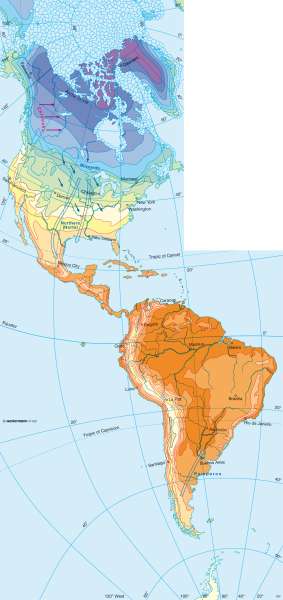January temperature
The Americas - Climate
978-3-14-100790-9 | Page 126 | Ill. 1

Information
North AmericaBecause of the location and shape of North America, the weather throughout the year is marked by strong meridional exchanges of polar and tropical air masses, in particular, in the north-south extension of the Rocky Mountains along the west coast. This direct exchange of warm, moist air from near the equator and cold air masses from the polar regions, result in parts to extreme weather phenomena and formation of characteristic regional wind systems. Therefore, blizzards and northers in North America in the winter are the result of cold air intrusions from the north which are often associated with high winds and snowfalls. The blizzards often reach the sub-tropical crops in Florida, the influence of northers can even extend into central Mexico.
These cold air incursions fight alongside the rapid cooling of the landlocked countries with low temperature distribution in January. In the east of the Cordillera, the isotherms hollow out strongly and partly southwards. Through the coast parallel mountains in the west and east of the continent, the warm influence of the sea is only limited to a narrow coastal strip, in which the isotherms are clearly bulging northwards.
South America
In South America, there are also cold-air intrusions in the polar regions described as Pamperos. Apart from these cold waves, which are clearly characterised in the seasonal temperature changes, is the transition from tropical daytime climate to extratropical annual climate. While in the equatorial tropical areas, January and July average temperatures vary only very slightly, sometimes showing large temperature amplitudes in the daily cycle. With increasing latitude, the seasonal temperature differences increase. This is particularly evident beyond the tropics.Significantly, distinctive differences in temperatures in the north-south direction is the zoning of temperature with height. The level of frost-free lowland tropics in South America, such as in the Tierra caliente (annual average temperature above 22 °C) and Tierra templada (annual average temperature 16—22 °C), are denoted. In the area of the equator, this altitude level of complete frost-free areas reaches about 2,500m and decreases towards the poles. With annual average temperatures from 6—16 °C, regular frosts occur in the area of Tierra fria. At an altitude of about 3,500 m, annual average temperatures of 0—6 °C are reached in the equatorial zone of the Andes of Tierra helada. The number of changeable frost and ice days increase considerably. The Tierra Nevada, is indicated as an area of permanent snow, and starts in the humid inner tropics at about 5,000 m.
A. Siegmund; Ü: Colette Fleming




